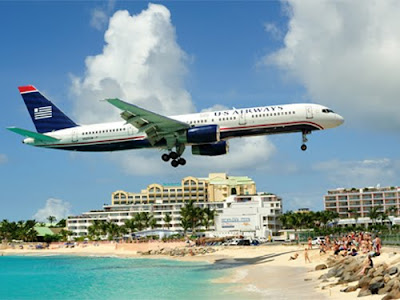The most dangerous airports in the world, from offshore airports in japan to ice covered ones in Antartica to an airport which has a road that runs through it in Gibraltar!
Lukla Airport Nepal
Since Lukla Nepal is the place most people start their Mount Everest trek, this Himalayan strip gets quite a bit of traffic--mostly to and from Kathmandu.
Sirens inform folks for miles when an airplane is landing here, and as you would suspect, only helicopters and Twin Otter type planes can handle the 2,000 foot, uphill runway that is fenced off at the end, to protect you from the edge of a mountain cliff.
Sirens inform folks for miles when an airplane is landing here, and as you would suspect, only helicopters and Twin Otter type planes can handle the 2,000 foot, uphill runway that is fenced off at the end, to protect you from the edge of a mountain cliff.
Kansai International Airport
Osaka, Japan
Land is a scarce resource in Japan, so engineers headed roughly 3 miles offshore into Osaka Bay to build this colossal structure. Work on the manmade island started in 1987, and by 1994 jumbo jets were touching down. Travelers can get from the airport to the main island of Honshu via car, railroad or even a high-speed ferry.
Gibraltar Airport
Between Morocco and Spain sits the tiny British territory of Gibraltar. Construction of the airport dates back to World War II, and it continues to serve as a base for the United Kingdom's Royal Air Force, though commercial flights land on a daily basis.
Madeira International Airport
Madeira, Portugal
Madeira is a small island far off the coast of Portugal, which makes an airport that is capable of landing commercial-size aircraft vital to its development. This airport's original runway was only about 5000 feet long, posing a huge risk to even the most experienced pilots and limiting imports and tourism.
Ice Runway
Antarctica

The Ice Runway is one of three major airstrips used to haul supplies and researchers to Antarctica's McMurdo Station. As its name implies, there are no paved runways here—just long stretches of ice and snow that are meticulously groomed.
There is no shortage of space on the Ice Runway, so super-size aircraft like the C-130 Hercules and the C-17 Globemaster III can land with relative ease. The real challenge is making sure that the weight of the aircraft and cargo doesn't bust the ice or get the plane stuck in soft snow. As the ice of the runway begins to break up, planes are redirected to Pegasus Field or Williams Field, the two other airstrips servicing the continent.
Congonhas Airport
Sao Paulo, Brazil

Most major cities have an airport, but rarely are they built just 5 miles from the city center, especially in metropolises like Sao Paulo. Congonhas' close proximity to downtown can be attributed in part to the fact that it was completed in 1936, with the city experiencing rapid development in the following decades.
Courchevel International Airport
Courchevel, France

Getting to the iconic ski resort of Courchevel requires navigating the formidable French Alps before making a hair-raising landing at Courchevel International Airport. The runway is about 1700 feet long, but the real surprise is the large hill toward the middle of the strip.
Princess Juliana International Airport
Simpson Bay, Saint Maarten
Nothing says fun in the sun like roaring engines and the smell of jet exhaust. Landing on this Caribbean island forces pilots to fly over a small strip of beach, clear a decent-size fence and pass over a road just before hitting the runway.
Svalbard Airport
Svalbard, Norway
Svalbard is a cluster of Norwegian islands sitting in the Arctic Ocean. While there are three airports within the archipelago, two of which are used mainly to transport miners, Svalbard Airport is open to commercial travel, making it the world's northernmost airport that tourists can book tickets to.
Juancho E. Yrausquin Airport
Saba, Netherlands Antilles
Getting to this paradise-like island can be a bit distressing thanks to a 1300-foot-long runway, slightly longer than most aircraft carrier runways.





